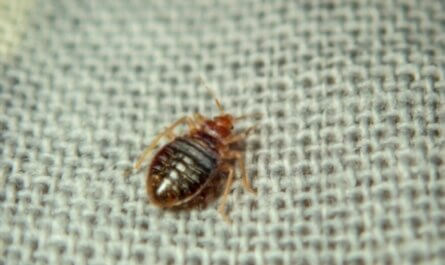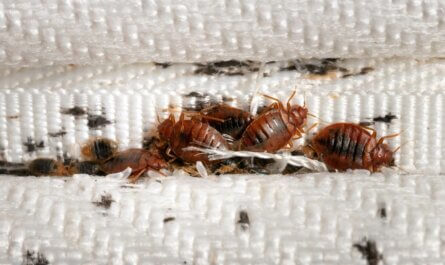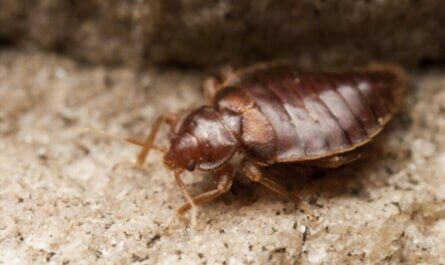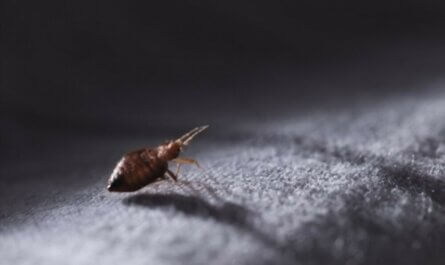Are you itching to know how bed bugs enter your home and make their nests? You’re not alone; many people live in fear of these tiny infestations. This blog post will help explain what attracts these pests, how they travel from place to place, and the telltale signs of a bed bug infestation.
Let’s dive right into unmasking the mystery behind these annoying household invaders!
Key Takeaways
- Bed bugs can enter your home through transmission in luggage or clothing, infested furniture, and infested public areas.
- They are attracted to heat and carbon dioxide, as well as cluttered environments and the presence of other bed bugs.
- To prevent a bed bug infestation, inspect used furniture before bringing it inside, keep living spaces clean and clutter-free, and be vigilant when traveling or visiting public areas.
What are Bed Bugs?
Bed bugs are small insects that feed on the blood of humans and animals, typically at night when they are most active.
Identifying bed bugs
Bed bugs pose a serious issue for many homeowners, and identifying them is the first step towards resolving this problem.
- Bed bugs are visible to the naked eye, although their small size can make detection difficult. They generally have a brownish appearance which is easily noticeable.
- Adult bed bugs resemble apple seeds in size and shape, making them distinguishable from other insects.
- These parasitic creatures prefer feeding on humans, but they won’t hesitate to feed on other animals if necessary.
- Evidence of an infestation often comes from finding the bugs themselves in your home.
- You might also identify bed bugs through experiencing bites that bear similarity to those from mosquitoes or fleas.
- One of the key ways of spotting bed bugs is to look out for varying reactions to these bites among individuals with allergies or sensitivities.
Signs of a bed bug infestation
Keeping an eye out for the signs of a bed bug infestation can help alert you to a potential problem early on. Here are some key indicators to look for:
- Spotting rusty or reddish stains on bed sheets, mattresses, or walls, which are often the result of crushed bed bugs.
- Noticing dark spots about the size of this mark: •. These may show up on your bedding and are bed bug excrement.
- Discovering tiny eggs or eggshells, usually about one millimeter in size.
- Finding pale yellow skins that young bed bugs shed as they grow into adults.
- Observing live bed bugs moving around after lifting mattress seams, running along headboards, or crawling across furniture.
- Feeling itchy red welts appearing on your skin overnight in a line or clustered together.
Where Do Bed Bugs Come From?
Bed bugs can come from various sources, including traveling, buying used furniture, and common public places.
Traveling
High-turnover places like hotels are notorious hideouts for bed bugs. As travelers, individuals can unsuspectingly pick up these pests on their clothing, linens or in the seams of their luggage during both domestic and international travel.
This accidental collection often leads to infestations upon return home. Since bed bugs can burrow into fabric folds and crevices, they easily hitch a ride and spread from one place to another unnoticed.
To minimize the risk of bringing these unwanted souvenirs back with you, it’s essential to keep personal items and luggage away from beds while traveling.
Buying used furniture
Buying used furniture can be a cost-effective option for many people, but it is important to be aware that bed bugs can easily hitch a ride on these items. Bed bugs are attracted to upholstered furnishings because they can burrow into the fabric and hide in pleats and seams.
So, if you’re considering purchasing secondhand furniture, make sure to thoroughly inspect it for signs of bed bugs before bringing it into your home. It’s also recommended to treat the furniture for bed bugs before introducing it into your living space.
By taking these precautions, you can help prevent a potential infestation and keep your home bug-free.
Common public places
Common public places such as hotels, offices, airports, libraries, nursing homes, buses, and trains can be breeding grounds for bed bugs. These pests are attracted to these areas because they provide easy access to human hosts and plenty of hiding spots.
Individuals who have unknowingly picked up bed bugs from infested areas can bring them into these public spaces. It’s important for homeowners, renters, landlords, and pest control professionals to be aware of the risk of infestation in common public places.
Regular inspection and cleaning of mattresses, furniture, and other potential hiding spots can help detect and prevent bed bug infestations in these areas frequented by travelers or people living in urban environments.
Second-hand furniture buyers should also exercise caution when bringing used items into their homes or businesses. Healthcare facilities and Airbnb hosts must also remain vigilant to ensure a clean and safe environment for their patients or guests.
How Do Bed Bugs Enter Homes?
Bed bugs enter homes through transmission in luggage or clothing, infested furniture, and infested public areas.
Transmission through luggage or clothing
Bed bugs can easily hitch a ride on your belongings and find their way into your home. Here are some ways they can be transmitted through luggage or clothing:
- Bed bugs can crawl onto clothes or linens in infested areas, such as hotels, airplanes, or public transportation.
- They can hide in the seams and folds of luggage, backpacks, or purses.
- Used furniture, including mattresses and upholstered items, can also harbor bed bugs that then transfer to your belongings.
Infested furniture
Infested furniture can lead to the spread of bed bugs. When purchasing second-hand beds or furniture, it’s important to be cautious as it can accelerate bed bug outbreaks. These pests often hide in the seams or cushions of chairs, couches, curtains, and wall hangings.
Infested furniture can serve as a potential food source for bed bugs attracted to carbon dioxide. Identifying bed bugs is essential in getting rid of an infestation. To avoid bringing them into your home or property, make sure to inspect any used furniture thoroughly before bringing it inside.
Take extra precautions if you live in an urban area or frequently travel, as these are common ways that bed bugs can be introduced into your space.
By being proactive and aware of the risks associated with infested furniture, you can help prevent the spread of these pesky insects and maintain a clean and pest-free environment.
Infested public areas
Bed bugs can be found in various public areas, posing a risk of infestation. Here are some places where bed bugs often lurk:
- Hotels and motels: These establishments can be breeding grounds for bed bugs, especially if proper pest control measures are not in place.
- Theaters and cinemas: Dark and cozy spaces like movie theaters provide an ideal environment for bed bug infestations.
- Public transportation: Buses, trains, and taxis can unknowingly transport bed bugs from one location to another, making them potential breeding grounds.
- Libraries and bookstores: Bed bugs can hide in the pages of books or in the upholstery of chairs and sofas found in these places.
- Hospitals and healthcare facilities: Although healthcare providers take steps to prevent infestations, bed bugs can still find their way into hospitals through visitors or patients.
- Schools and universities: Shared spaces such as dormitories or classrooms can become infested with bed bugs, spreading to backpacks or clothing.
- Laundromats: Infested bedding or clothing brought into a laundromat can transfer bed bugs to other customers’ belongings.
- Shopping malls: Bed bugs have been known to hitch a ride on shoppers’ bags or clothing items, potentially leading to home infestations.
What Attracts Bed Bugs?
Bed bugs are attracted to heat and carbon dioxide, cluttered environments, and the presence of other bed bugs. Curious to know how these factors play a role in attracting these pesky insects? Keep reading to find out!
Heat and carbon dioxide
Bed bugs are attracted to heat and carbon dioxide. These irritating pests are drawn to the warmth and breath of warm-blooded animals, including humans. In fact, when we sleep, we release carbon dioxide, which acts as a lure for bed bugs.
They also use heat as a cue to locate their hosts. This means that if you have body heat or exhale carbon dioxide, you could unwittingly attract bed bugs into your home or even while traveling.
Being aware of these factors can help you take preventative measures like using repellents or traps to keep them at bay.
Cluttered environments
Cluttered environments, such as untidy or disorganized spaces, can attract bed bugs. Bed bugs are more likely to infest areas that are messy or neglected because they provide hiding spots and easy access to their food source – human blood.
The presence of clutter creates more places for the bed bugs to hide and makes it harder to spot an infestation. It is important for homeowners, renters, landlords, and individuals in general to keep their living spaces clean and free of clutter in order to reduce the risk of a bed bug problem.
This is especially crucial in bedrooms where people spend most of their time resting and sleeping. Cleaning up and decluttering can help prevent bed bug infestations and make it easier to detect them if they do occur.
Presence of other bed bugs
Bed bugs are social insects that often live together in large groups. This means that if there are already bed bugs present in your home or accommodation, it’s more likely for other bed bugs to be attracted and join the infestation.
Bed bugs produce a chemical called histamine, which can serve as a signal to other bed bugs that an area is suitable for feeding and reproducing. So, if you find evidence of bed bug activity, it’s important to take immediate action to prevent their numbers from growing and spreading further throughout your living space.
Additionally, if you live in an apartment building or have neighbors who have experienced a bed bug problem, there is also a higher risk of attracting these pesky pests into your home.
Bed bugs can easily travel through wall voids, electrical outlets, and pipes to move from one unit to another. So even if you haven’t encountered any signs of bed bugs yet, it’s wise to stay vigilant and take preventive measures such as regular inspections and keeping clutter under control.
To protect yourself from attracting more bed bugs into your home or accommodation:
– Take swift action at the first sign of a bed bug infestation.
– Keep your living environment clean and clutter-free.
Symptoms of Bed Bug Bites
Bed bug bites typically result in itchy, red welts on the skin, often appearing in clusters and sometimes causing a delayed reaction.
Itchy, red welts
Bed bug bites can cause itchy, red welts on your skin. These bites often appear in a zigzag pattern and may be accompanied by a flat area of redness around them. Almost all bed bug bites result in some degree of itchiness and inflammation.
It’s important to note that the severity of symptoms can vary from person to person, with some individuals experiencing severe reactions such as blisters or hives. If you notice these itchy, red welts on your body, it is advisable to seek medical attention or consult a pest control professional for further assistance.
Clustered bites
Bedbug bites can often appear in clusters or lined up in rough rows on exposed areas of the body. These swollen, red spots are commonly itchy and may cause skin irritation. If you notice these clustered bites upon waking or one to several days later, it could be a sign of a bedbug infestation.
It’s important to take immediate action to prevent further sleep disturbances and potential allergic reactions.
Delayed reaction
Delayed reactions to bed bug bites are more common than immediate reactions. It can take anywhere from a few hours to two weeks for symptoms to appear after being bitten. In some cases, it may even take a week or longer.
This delayed timeframe can lead to confusion about the source of the bites, as people may not connect them to bed bugs right away. Additionally, the first time someone is bitten by bed bugs, they may not experience itching immediately.
This delayed onset of symptoms highlights the importance of vigilance and thorough inspections when dealing with potential bed bug infestations in homes, hotels, or other public spaces.
How to Check for Bed Bugs in Your Home
Inspect your bedding and furniture thoroughly, looking for live bed bugs, fecal spots, or shed skins.
Inspecting bedding and furniture
Inspecting bedding and furniture is a crucial step in identifying and eradicating a bed bug infestation. Here are some key areas to check for signs of bed bugs:
- Bed sheets: Look for rusty or reddish stains, which could be bed bug excrement.
- Mattresses: Examine the seams, piping, and tags for any dark spots or clusters of bed bugs.
- Upholstered items: Check the cushions, sofas, and chairs for any signs of bed bug activity, such as live bugs or shed skins.
- Cracks and crevices: Bed bugs are skilled at hiding in small spaces. Use a flashlight to inspect baseboards, headboards, and other tight spots.
- Furniture joints: Pay close attention to any cracks or gaps in wooden furniture, as these can provide hiding places for bed bugs.
- Other potential hiding spots: Don’t forget to check behind picture frames, electrical outlets, and even inside alarm clocks or telephones.
Examining cracks and crevices
Inspecting cracks and crevices is an important step in checking for bed bugs in your home. Here’s what you need to do:
- Shine a flashlight into cracks and crevices to look for signs of bed bug infestation, such as rusty or reddish stains.
- Look for dark spots of dried bed bug excrement in these hiding places.
- Pay special attention to areas near the bed, such as the headboard, mattress seams, and box springs.
- Don’t forget to check other furniture too, like nightstands and dressers.
- Take a close look at any cracks or crevices in the walls or floors, as bed bugs can hide there as well.
Hiring a pest control professional
To effectively deal with a bed bug infestation, hiring a pest control professional is highly recommended. These professionals have the experience and expertise in treating bed bugs and know the most effective solutions to eradicate them.
It’s important to check the credentials of the pest control company before making a decision, ensuring they have a track record of successfully controlling bed bugs.
By hiring a reputable professional, homeowners, renters, landlords, and anyone dealing with bed bugs can have peace of mind knowing that their infestation will be properly addressed by someone who knows what they’re doing.
Conclusion
In conclusion, understanding how bed bugs start is crucial for preventing and addressing infestations. By knowing where they come from, how they enter homes, and what attracts them, homeowners can take proactive measures to protect themselves.
By learning the symptoms of bed bug bites and knowing how to check for them in your home, you can catch an infestation early and seek professional help if needed. With proper knowledge and vigilance, you can keep these unwanted pests at bay and maintain a comfortable living environment.
FAQs
Where do bed bugs come from?
Bed bugs can come from various sources, including infested furniture, luggage, clothing, or even other people who unknowingly transport them.
How do bed bugs enter my home?
Bed bugs can enter your home by hitchhiking on infested items such as used furniture or through cracks and crevices in walls or floors.
Can I get bed bugs from a hotel?
Yes, it is possible to get bed bugs from a hotel if the room you stay in has an infestation. Bed bugs can easily latch onto your belongings and travel back with you to your home.
What are common signs of a bed bug infestation?
Common signs of a bed bug infestation include finding small red bite marks on your body, blood stains on sheets or pillowcases, rusty-colored spots on bedding or mattresses, and the presence of live insects hiding in mattress seams or other hidden areas.
How can I prevent a bed bug infestation in my home?
To prevent a bed bug infestation, regularly inspect second-hand furniture before bringing it into your home, use protective covers for mattresses and box springs, keep clutter to a minimum to reduce hiding places for pests, and be cautious when traveling to avoid bringing back unwanted guests.





